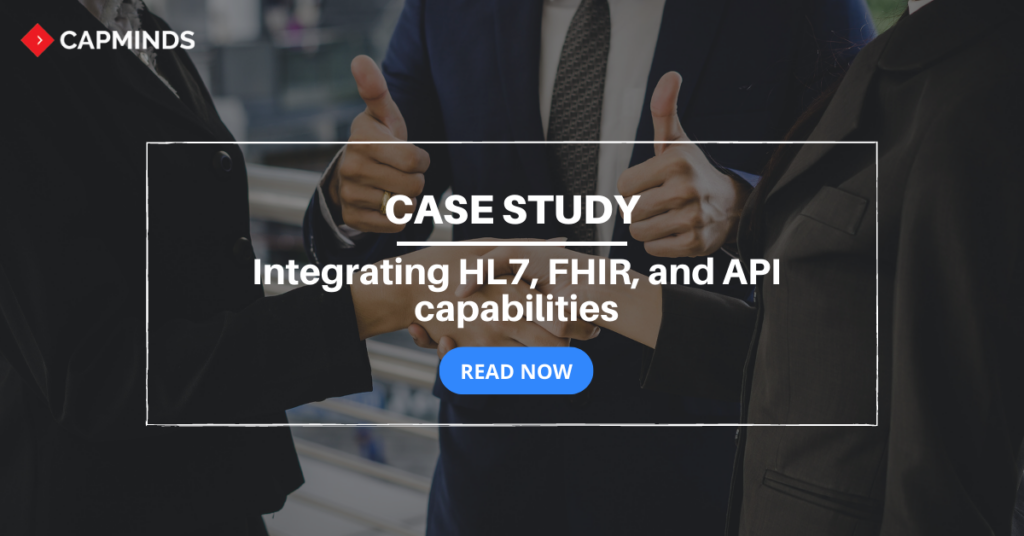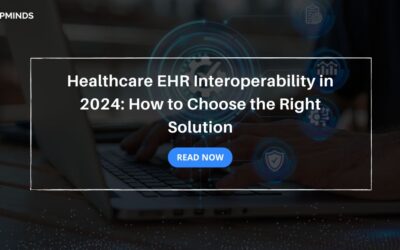Case Study: Integrating HL7, FHIR, & API Capabilities with CapMinds
Client Overview
The company is a consulting organization that promotes quality healthcare through contracts with federal, state, and local governments as well as private organizations.
The increase in government reporting and requirements have pushed healthcare organization to seek extensive expertise to solve distinctive healthcare challenges. The organization carries out statewide medical review efforts and quality improvement services across the United States. Healthcare providers of all levels depend on their resources to assist in fulfilling the rules and requirements of different federal quality improvement programs. Service areas include the implementation of new quality improvement projects, monitoring and evaluation, knowledge dissemination, technical assistance and/or training, and quality assurance.
Business Challenges
- As a healthcare quality improvement initiative non-profit, the organization receives data feeds from hospitals, health systems, HIEs, government agencies, and programs (such as Medicaid and Medicare). The data is validated, parsed, normalized, and loaded into their SQL database.
- The organization examines data fed directly from clinical chart systems. Their contracts’ data feeds were mostly in CDA format.
- As a Hospital Quality Improvement Contractor (HQIC) under the CMS, the organization targeted on providing quality improvement assistance to the Opioid epidemic and patient safety.
- HQICs must use innovation to find results and implement data-driven quality improvement interventions.
- The challenge to their internal IT team was to build out HL7, FHIR, and API integration capabilities quickly and easily. The first requirement was to integrate HL7 feeds of EMR data from Epic, Cerner, and others from over 30 hospitals.
- The second requirement was identifying a budget-friendly solution that would be within their current contract parameters.
- Time with marketing was also a challenge for them.
- They decided to buy expertise and not build an internal system because of the maintenance costs, and building a new one was outside their IT team’s competency.
- This necessitated evaluating a comprehensive list of healthcare integration vendors.
Our Approach
This Healthcare Quality Improvement Company works with hospitals focused on improving clinical areas which are prioritized by the CMS for US healthcare. These measures use data related to providers’ capability to deliver high-end care or goals with a long span for quality healthcare.
The company licensed the CapMinds Integration for Healthcare to build up its internal IT capability to integrate any variety of HL7 messaging, handle FHIR interoperability and share data with APIs. CapMinds stood out as the most cost-effective solution to serve their growing number of hospitals as CapMinds has no per connection, per interface, or transaction fees.
In addition to these capabilities, the users can also work with any type of data format. CapMinds’s no coding or scripting approach meant that business analysts could take on a large percentage of the integration work freeing up the company’s developers and further reducing costs.
The Outcomes
- CapMinds participated in the evaluation. The peculiar advantage of CapMinds over other solutions is that interfaces can be easily prototyped using its Graphical Interface Assembly Line process.
- The client provided sample files. With these, CapMinds was able to quickly configure an interface to visually demonstrate to the client. In the demo, by stepping through CapMinds’s Assembly Line, the client could see exactly how CapMinds’ Console IDE would connect to the source system, transform the data, graphically perform end-to-end testing, mapping of data, and transfer the data to its internal system.
- The CapMinds solution facilitated rapid interface development so that the client could scale the solution on a demanding timeline to serve more and more hospitals.
- With CapMinds, there were also cost benefits such as:
- No costs per connection, interface, or transaction fees.
- No extra fees for test instances or cold backups, and development.
- Extra cost budgets for bandwidth are not needed.
- Having met all their criteria and more, CapMinds was awarded the contract. The client also benefited from CapMinds’ shorter training period.
- Their developers participated in CapMinds’s standard 32- hour training program. The training included demos of the product functionalities and its features along with hands-on exercises.
- Then came the rebuilding of an interface template illustrative of the client’s use case.
- Everything combined gave the team the appropriate experience required to become productive and efficient.
- The client’s team leveraged CapMinds’s graphical Automated Interface Assembly Line process to quickly architect new workflows while being guided by CapMinds’s support team to ensure best practices were being followed.
- CapMinds’s flexible support plan allowed developers to reach out for support via phone, email, or chat as needed, with a quick response time to eliminate delays. Implementation leaped forward as every interface no matter how complex was configured using the same repeatable process.
- The team also leveraged CapMinds’s visual Data Mapper. The in-built format builders and transformation module facilitated them to create mappings by using drag & drop.
- No scripting was required. The CapMinds Data Mapper utilizes W3C standard XSLT generated under the covers. With CapMinds, the team had the option of working in the graphical or XSLT view and could switch back and forth between the two.
- Other products being evaluated required proprietary scripting (which locks you into a vendor) and lacked true graphical mapping capabilities.
- CapMinds’s configuration vs code-driven process enabled the client’s business analysts and non-developers to perform part of the integration work, freeing up their developers for other projects.
- They enjoyed higher ROI with more savings on the cost and time.
- Not being nickel-and-dimed once the number of contracts and connections scaled up was a major reason for selecting CapMinds.
- Importantly, CapMinds base licensing includes every component of the Console IDE – processors, listeners, transport adapters, and supported data formats – at no extra cost.
- CapMinds’s architecture facilitates interface reuse which played a huge role in the speed the solution was rolled out. Guaranteed deadlines were met efficiently and timelines of contracts were adhered to.
Healthcare Quality Improvement Services From CapMinds
CapMinds’s extensible and flexible architecture ensures that the company going forward will be able to integrate with electronic healthcare records HL7 2.x messaging, share data via APIs, and be FHIR interoperable if required. CapMinds also supports HL7 2.x, HL7 3.x, FHIR, CDA/C-CDA, X12 EDI, NCPDP, DICOM, and more.
The robust CapMinds Hybrid Integration Platform integrates data and applications across on-premises, cloud, hybrid, or multi-cloud environments. With CapMinds’s built-in foundation to support multiple data formats and industry standards, the company will soon be looking at all potential data that would map to specific quality improvement steps.
One of the major steps is the reduction in adverse drug events to achieve Medicaid and Medicare goals for healthcare organizations and providers. Using CapMinds Technology, each new implementation can be achieved by cloning earlier efforts and only making minor modifications in configuration saving enormous amounts of time. This facilitates the easy maintaining, managing, and updating of interfaces without depending on those who created them originally.
Seeing CapMinds in action, the company is confident that CapMinds will easily meet every challenge and virtually integrate with anything and everything, now and in the future. The bottom line is that CapMinds delivered everything expected and more, plus an impressively high Return on Investment (ROI).
“Reduce your overbearing challenges and step towards a higher functionality by choosing CapMinds Technology”




